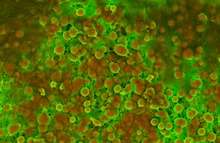Calcification
Calcification is the accumulation of calcium salts in a body tissue. It normally occurs in the formation of bone, but calcium can be deposited abnormally in soft tissue,[1][2] causing it to harden. Calcifications may be classified on whether there is mineral balance or not, and the location of the calcification.[3] Calcification may also refer to the processes of normal mineral deposition in biological systems, such as the formation of stromatolites or mollusc shells (see Mineralization (biology) or Biomineralization).

Signs and symptoms
Calcification can manifest itself in many ways in the body depending on the location.
Causes of soft tissue calcification
Calcification of soft tissue (arteries, cartilage, heart valves,[1][2] etc.) can be caused by vitamin K2 deficiency or by poor calcium absorption due to a high calcium/vitamin D ratio. This can occur with or without a mineral imbalance.
Intake of excessive vitamin D can cause vitamin D poisoning and excessive intake of calcium from the intestine, when accompanied by a deficiency of vitamin K (perhaps induced by an anticoagulant) can result in calcification of arteries and other soft tissue.[4] Such metastatic soft tissue calcification is mainly in tissues containing "calcium catchers" such as elastic fibres or sour mucopolysaccharides. These tissues especially include the lungs (pumice lung) and the aorta.[5]
Mineral balance
- Dystrophic calcification, without a systemic mineral imbalance.
- Metastatic calcification, a systemic elevation of calcium levels in the blood and all tissues.
Forms
Calcification can be pathological or a standard part of the aging process. Nearly all adults show calcification of the pineal gland.[6]
Location
- Extraskeletal calcification, e.g. calciphylaxis
- Brain, e.g. primary familial brain calcification (Fahr's syndrome)
- Tumor calcification[7]
- Arthritic bone spurs
- Kidney stones
- Gall stones
- Heterotopic bone
Pattern
Patterns of calcifications may indicate pathological processes. Laminated appearance suggests granulomatous disease while popcorn calcification indicates hamartoma. Malignant lesions may have stippled or eccentric calcification.
Breast disease
In a number of breast pathologies, calcium is often deposited at sites of cell death or in association secretions or hyalinized stroma, resulting in pathologic calcification. For example, small, irregular, linear calcifications may be seen, via mammography, in a ductal carcinoma-in-situ to produce visible radio-opacities.[8]
Diagnosis
In terms of diagnosis, in this case vascular calcification, an ultrasound and radiography of said area is sufficient.[9]
Treatment
Treatment of high calcium/vitamin D ratio may most easily be accomplished by intake of more vitamin D if vitamin K is normal. Intake of too much vitamin D would be evident by anorexia, loss of appetite, or soft tissue calcification.
References
- Bertazzo, Sergio; Gentleman, Eileen; Cloyd, Kristy L.; Chester, Adrian H.; Yacoub, Magdi H.; Stevens, Molly M. (2013). "Nano-analytical electron microscopy reveals fundamental insights into human cardiovascular tissue calcification". Nature Materials. 12 (6): 576–583. doi:10.1038/nmat3627. ISSN 1476-1122. PMC 5833942. PMID 23603848.
- Miller, J. D. Cardiovascular calcification: Orbicular origins. Nature Materials 12, 476-478 (2013).
- Calcification The American Heritage Science Dictionary. Retrieved 2013-03-23.
- Paul Price, et al., "Warfarin-Induced Artery Calcification Is Accelerated by Growth and Vitamin D", Arteriosclerosis, Thrombosis, and Vascular Biology, 2000, Vol. 20, pp. 317-327.
- McGavin, Zachary. Pathologic basis of veterinary disease, fourth edition; Elsevier 2007.
- Zimmerman, Robert A. "Age-Related Incidence of Pineal Calcification Detected by Computed Tomography" (PDF). Radiological Society of North America. Archived from the original (PDF) on 2012-03-24. Retrieved 21 June 2012.
- calcification in ovarian tumours
- Robbins and Cotran (2009), Pathologic Basis of Disease, 8th edition, Elsevier.
- Raggi, Paolo; Bellasi, Antonio (2007). "Clinical assessment of vascular calcification". Advances in Chronic Kidney Disease. 14 (1): 37–43. doi:10.1053/j.ackd.2006.10.006. ISSN 1548-5595. PMID 17200042.